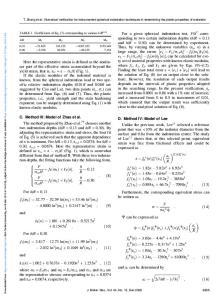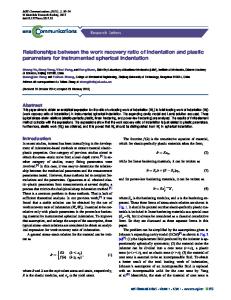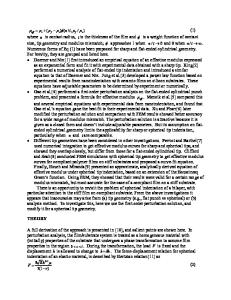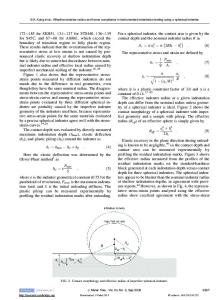An energy-based method for analyzing instrumented spherical indentation experiments
- PDF / 659,043 Bytes
- 9 Pages / 612 x 792 pts (letter) Page_size
- 13 Downloads / 371 Views
Yang-Tse Chenga) Materials and Processes Laboratory, General Motors Research and Development Center, Warren, Michigan 48090
Che-Min Cheng Institute of Mechanics, Chinese Academy of Sciences, Beijing 100080, People’s Republic of China
David S. Grummon Department of Chemical Engineering and Materials Science, Michigan State University, East Lansing, Michigan 48824 (Received 16 June 2003; accepted 23 September 2003)
Using dimensional analysis and finite element calculation, we studied spherical indentation in elastic–plastic solids with work hardening. We report two previously unknown relationships between hardness, reduced modulus, indentation depth, indenter radius, and work of indentation. These relationships, together with the relationship between initial unloading stiffness and reduced modulus, provide an energy-based method for determining contact area, reduced modulus, and hardness of materials from instrumented spherical indentation measurements. This method also provides a means for calibrating the effective radius of imperfectly shaped spherical indenters. Finally, the method is applied to the analysis of instrumented spherical indentation experiments on copper, aluminum, tungsten, and fused silica.
I. INTRODUCTION
Since the inception by Brinell about 100 years ago, spherical indentation techniques have become industry standard methods for measuring the hardness of materials.1–4 Recent years have seen increasing interest in instrumented spherical indentation techniques for measuring the mechanical properties of materials across multiple length scales. By analyzing the load–displacement curves, several authors have suggested methods of obtaining hardness, elastic modulus, stress–strain relationships, and residual stresses from instrumented spherical indentation measurements.5–12 However, most of the previously proposed methods depend on the estimation of the contact area under the spherical indenter, which is difficult especially when the surface around the indenter exhibits “piling-up.”13–16
a)
This author was an editor of this focus issue during the review and decision stage. For the JMR policy on review and publication of manuscripts authored by editors, please refer to http:// www.mrs.org/publications/jmr/policy.html J. Mater. Res., Vol. 19, No. 1, Jan 2004
http://journals.cambridge.org
Downloaded: 13 Mar 2015
By extending a recently developed scaling approach17,18 to spherical indentation in elastic–plastic solids with work-hardening, we reveal, in this paper, two previously unknown relationships between hardness, reduced modulus, indentation depth, indenter radius, and work of indentation. Together with a well-known relationship5 between reduced modulus, initial unloading slope, and contact area, we propose an energy-based method of determining the contact area, reduced modulus, and hardness of materials from instrumented spherical indentation experiments. This method also provides a way of calibrating the effective radius of imperfect spherical indenters. The validity of the method is tested
Data Loading...











